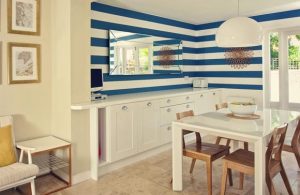Colours and Interior Design
Interior designers always consider colours when they are putting together designs for a room or space. There will be colours that their clients are drawn to, and equally colours they want to avoid. There are colours that will optimise the room and create certain effects.
When we commence a project, we take the time to get to know our clients, their tastes and preferences and desired finish for each room. We build a design around that and get creating. So, what can colour bring to your room?
Blue
This calming, meditative colour works well for workspaces, and rooms in which you wish to relax in. Blue can sometimes be thought of as a cold colour, but a room with plenty of natural light and sunlight work perfectly with blue hues. Organic material, such as wicker and wood, has innate warmth and will add texture and balance to a blue room. Blue is extremely versatile; use it in any room and to create a variety of themes. Used with white, blue gives a feel of lightness and freshness, opening up small spaces.

Green
Bring the outdoors in with the use of green in your room. There are many different shades of green, from emeralds and forest greens which are vibrant and contemporary to pastel hues which work well in a more classic scheme. Aside from the décor, greens look great in velvets and you can use faux greenery to complement the tones.
Yellow
Yellow is a welcoming colour and it can be used to warm up and brighten up spaces without windows and with a lack of light. For these reasons, yellow is perfect for entryways and hallways. To avoid yellow being overwhelming, it is especially suited to accent the room whether that is with a feature wall or selected yellow accessories. Yellow particularly suits Scandinavian themes and is very effective when paired with navy blues.
White
White is the most commonly used colour in interior design, whether it’s ceilings and woodwork or fittings and walls, it is a solid choice. White reflects light so can be used to make spaces seem larger and rooms more spacious. This neutral colour can be used to complement a bold accent colour, such as black or gold. It can also be used with great effect to showcase architectural features and as a backdrop for artwork. To avoid a room feeling cold from the use of a lot of white, use accessories with warm colours and introduce textures or accent colours. White will help you create a minimalist, modern look.

Colour affects our moods, so choosing the right colours within your home is vital. If you’re not sure how to achieve the desired effects contact us.
Follow our Facebook page for more interior trends and ideas.
May 2019
Tags: Bedfordshire, Interior Design, Interior Designer, New Build, Scandinavian interior design
